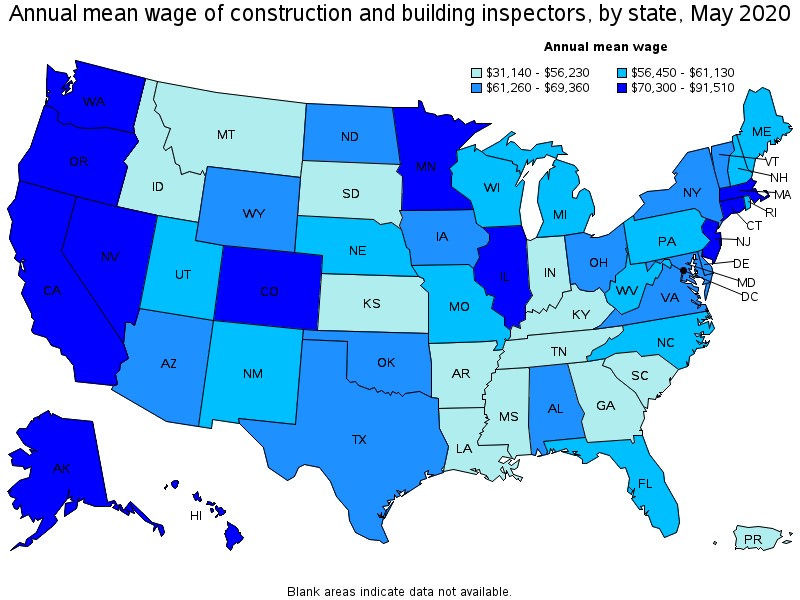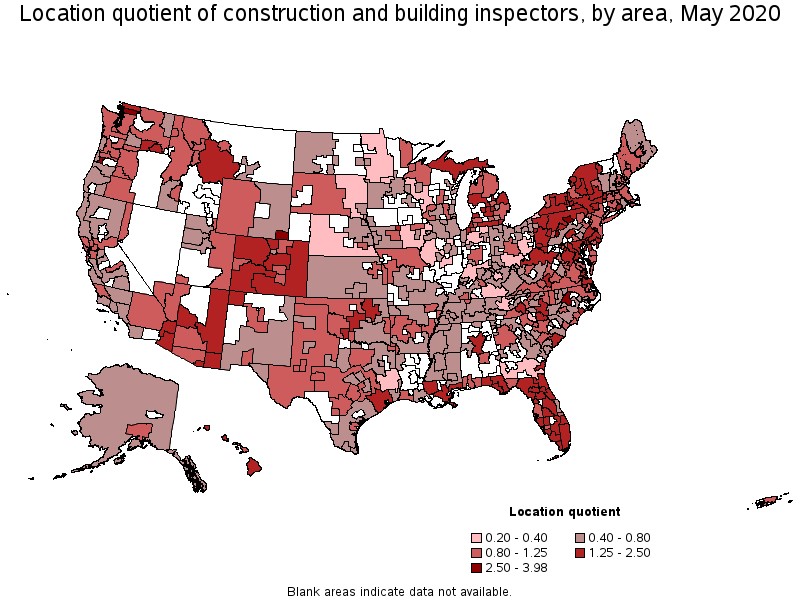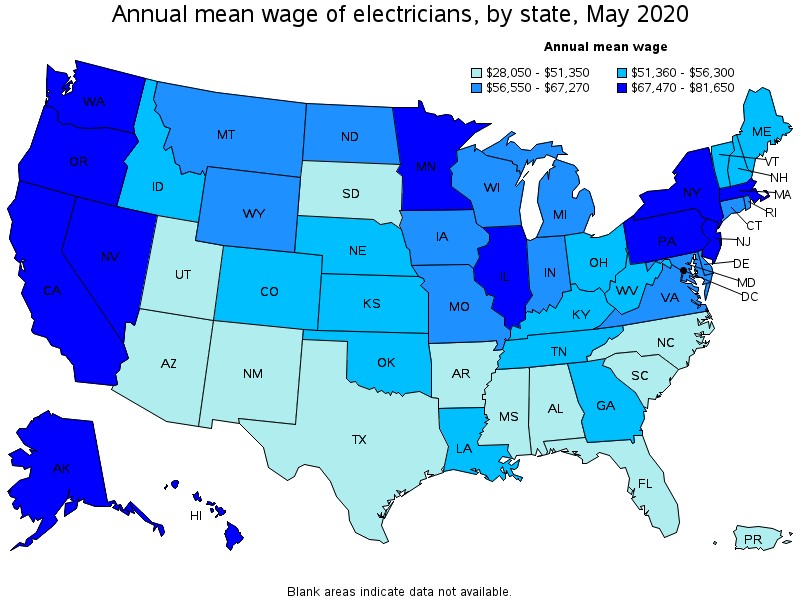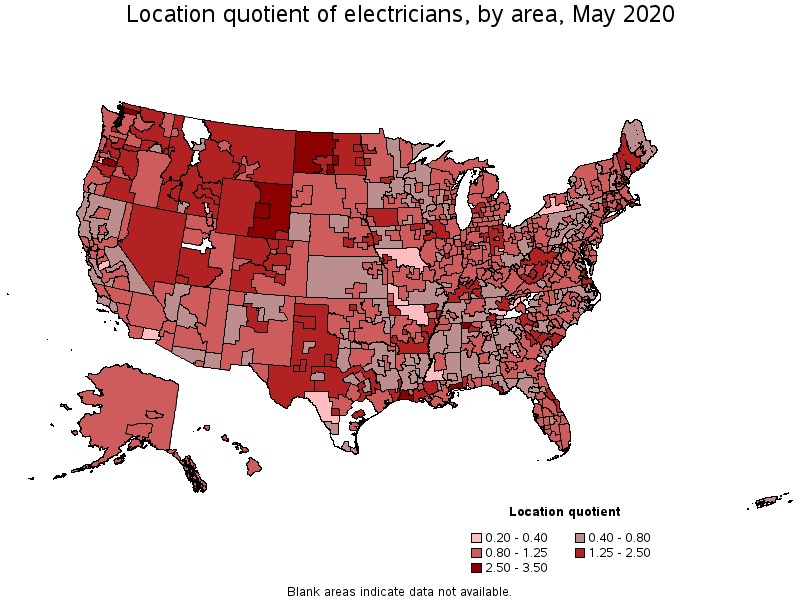In 2019, IAEI ran a workforce survey with over 1,500 individual responses from over 608 authority having jurisdictions (AHJs), 311 electricians, and over 643 other electrical professionals. AHJs reported an annual base salary of $75,000, which exceeded the $63,150 base pay reported by the Department of Labor Bureau of Labor Statistics. Electricians (non-contractors) also reported an average of $59,100 per year. In 2020, multiple industries across all sectors reported changes in employment, and the electrical industry was not immune. Here is an update from the 2020 and 2021 statistics for electrical inspectors, electricians, and other workers within the industry.
Electrical / Construction and Building Inspectors
The AHJ inspects electrical installations during construction or remodeling to enforce laws and ordinances establishing and maintaining minimum standards for residential, commercial, and industrial electrical installation and appliances. In 2019, the annual base pay as reported by the Bureau was $63,150 for construction inspectors. The annual base pay had increased in 2020 to $66,470 ($31.96 per hour) with an average of 5% raise1. The number of jobs for construction and building inspectors is expected to decline by 3 percent from 2020 to 2030. This decline is reflected in the trend toward reducing the number of inspectors within jurisdictions and the rise of multi-hat inspectors.

Salary and Employment Overview
As expected, the Bureau reported that local government jurisdictions (excluding schools and hospitals) reported the most employed inspectors at 42,390 in 2020. Architectural, engineering, and related services firms reported the next highest level at 38,070 inspectors. Additional industries reporting hiring AHJs include state government (excluding schools and hospitals; management, scientific and technical consulting services; and other professionals, scientific and technical services (such as utilities).
Across all industries, the percentile wage estimates for construction and building inspectors can be found in Table 1. The top five paying industries for construction and building inspectors can be found in Table 2. Insurance carriers report the highest hourly mean wage at $42.90 per hour.
| Percentile | 10% | 25% | 50% (Median) |
75% | 90% |
| Hourly Wage | $ 18.20 | $ 23.49 | $ 30.22 | $ 38.93 | $ 48.64 |
| Annual Wage | $ 37,850 | $ 48,860 | $ 62,860 | $ 80,970 | $ 101,170 |
Table 1. Percentile wages estimates for construction and building inspectors.
| Industry | Employment | Percent of industry employment | Hourly mean wage | Annual mean wage |
| Insurance Carriers | 100 | 0.01 | $ 42.90 | $ 89,240 |
| Electric Power Generation, Transmission and Distribution | 1,120 | 0.30 | $ 41.83 | $ 87,000 |
| Natural Gas Distribution | 860 | 0.80 | $ 41.76 | $ 86,860 |
| Commercial and Industrial Machinery and Equipment (except Automotive and Electronic) Repair and Maintenance | 150 | 0.07 | $ 41.40 | $ 86,120 |
| Rail Transportation | 650 | 0.31 | $ 39.44 | $ 82,040 |
Table 2. Top paying industries for construction and building inspectors.
Density by Location
The Bureau defines a “Location quotient” as the ratio of the area concentration of employment compared to the national area. In other words, an area has a higher (or lower) rate of employment than average in this particular region than other industries. For example, more people can be found working in the oil industry in Midland, Texas, than people working in hydropower and whatnot.

Metropolitan areas with the highest concentration of jobs and location quotients in Construction and Building Inspectors can be found in Table 3.
| Metropolitan area | Employment | Employment per thousand jobs | Location quotient | Hourly mean wage | Annual mean wage |
| Mount Vernon-Anacortes, WA | 150 | 3.26 | 3.98 | $ 34.28 | $ 71,310 |
| Corvallis, OR | 100 | 2.83 | 3.46 | $ 34.19 | $ 71,120 |
| Raleigh, NC | 1,610 | 2.59 | 3.16 | $ 31.74 | $ 66,020 |
| Trenton, NJ | 580 | 2.53 | 3.10 | $ 36.46 | $ 75,830 |
| Williamsport, PA | 120 | 2.51 | 3.07 | $ 26.99 | $ 56,130 |
| Cheyenne, WY | 100 | 2.26 | 2.77 | $ 34.11 | $ 70,940 |
| Altoona, PA | 110 | 2.09 | 2.56 | $ 27.91 | $ 58,050 |
| Crestview-Fort Walton Beach-Destin, FL | 220 | 2.02 | 2.47 | $ 29.69 | $ 61,760 |
| Walla Walla, WA | 50 | 1.88 | 2.30 | $ 34.83 | $ 72,460 |
| Norwich-New London-Westerly, CT-RI | 210 | 1.87 | 2.28 | $ 33.41 | $ 69,490 |
Table 3. Highest concentration of jobs and location quotients for AHJs by metro areas.
Nonmetropolitan areas with the highest concentration of jobs and location quotients in Construction and Building Inspectors can be found in Table 4.
| Nonmetropolitan area | Employment | Employment per thousand jobs | Location quotient | Hourly mean wage | Annual mean wage |
| Northern Pennsylvania nonmetropolitan area | 300 | 2.03 | 2.48 | $ 35.55 | $ 73,940 |
| Southwest Colorado nonmetropolitan area | 150 | 1.63 | 2.00 | $ 32.23 | $ 67,040 |
| Central East New York nonmetropolitan area | 230 | 1.50 | 1.83 | $ 26.98 | $ 56,110 |
| Western Pennsylvania nonmetropolitan area | 200 | 1.43 | 1.75 | $ 25.09 | $ 52,180 |
| South Florida nonmetropolitan area | 100 | 1.42 | 1.74 | $ 35.08 | $ 72,970 |
Table 4. Highest concentration of jobs and location quotients for AHJs by non-metro areas.
Getting Into the Field
The picture that emerges is a field of AHJs with years of experience working as electricians, contractors, and electrical engineers that are well-versed in the field of installations and the NEC. Inspectors recommend spending years in the electrical trade and studying hard, learning the requirements within the Code, and obtaining trade licenses. Acquiring technical skills is only the first step, respondents say. They also note that it is critical to work on people skills and develop a thick skin (“don’t argue or go by what think looks best or is common practice, let the Code decide”).
Here are a few other recommendations for people interested in becoming an electrical AHJ.
- Talk to other electrical AHJs in your area to learn the processes and to find job opportunities. As seen in the “How did you become an AHJ” section, sometimes that comradery helps you land your next position.
- Remember that everyone in the design, installation and approval process is working on getting to the same place, a safe installation.
- Join an organization such as IAEI (meet the local AHJs); study the current versions of the NEC, IRC, or IBC; and get an ICC certification as an Electrical Inspector.
- Be courteous, respectful, and always look for a way to reject/fail an inspection without being condescending. Expect major pushback and plan how to deal with that in advance. Keep a good attitude.
The main priority mentioned is to get your hands dirty and to do the work. Put in the time in the trenches of the actual install of work. Own the work. Learn how to lead others effectively and proficiently in the install aspect of the job. Lead by example. In your career, always teach others “how to check their work” and how to be thorough and what that looks like by physically showing them and taking the time to walk each other through the check your work together philosophy. Teach teamwork, teach always covering your coworkers’ back for the betterment of the team.
Get as much exposure to all aspects of the electrical industry from single-family dwelling, multi-family dwelling, small retail, large retail, hospitals, office buildings, nursing homes, industrial — all of it if possible, both doing the work and leading the work. It’s a learning experience every day, and it’s interesting to see new methods, techniques, and products daily. Take advantage of all installation aspects of the electrical industry — residential, commercial, industrial, public safety buildings, and high voltage (underground and overhead).
Read and study the code. Strive to understand not only how something should be done but why it is done that way. Once you understand the why, you will be better equipped to understand the intent of the code and if an installation can work, although it may not match the code exactly. Learn from the older generation how things have been done but be open to new technology that has been properly tested and approved.
Learn time management and how always to control the chaos. Never let chaos control you. Plan your work, always work your plan, and have backup plans to back up plans because unforeseen circumstances will destroy your plans. Be prepared to adapt quickly and always teach the rule book of the NEC, the specs and plans, City Ordinances, and the UL Listing processes, and what the UL White Book is. Read through all your blueprints, spec books, and product data — all of it. Know your jobs better than those who designed them. Know every aspect of your job installation. Never stop learning, teaching, and serving others in their quest to better themselves.

Electricians / Non-Contractors
Electricians are critical in installing, maintaining, and repairing electrical systems in residential dwellings, commercial installations, and industrial facilities2. The median base pay for electricians (non-contractors) reported in 2020 was $61,500 per year or $29.59 per hour, for an average of 4% raise for the year. The number of jobs for electricians in 2020 was 729,600, and the field is projected to grow 9 percent from 2020 to 2030, which is average. This is a growth of about 84,700 years annually.
Salary and Employment Overview
Building equipment contractors reported the highest levels of employment for electricians with 21.84% and 477,560 employed. Employment services, such as temporary services and whatnot, recorded the second highlight level of employment at 21,160. Local jurisdictions, excluding schools and hospitals, reported 13,780 electricians, followed by utility system constructions at 11,290. Nonresidential building construction firms reported hiring 9,710 electricians as workers.
Across all industries, the percentile wage estimates for electricians can be found in Table 5.
| Percentile | 10% | 25% | 50% (Median) |
75% | 90% |
| Hourly Wage | $ 16.26 | $ 20.57 | $ 27.36 | $ 36.24 | $ 47.46 |
| Annual Wage | $ 33,810 | $ 42,790 | $ 56,900 | $ 75,380 | $ 98,720 |
Table 5. Percentile wages estimates for electricians.
The top five paying industries for construction and building inspectors can be found in Table 6. Natural gas distribution companies report the highest hourly mean wage at $51.09 per hour.
| Industry | Employment | Percent of industry employment | Hourly mean wage | Annual mean wage |
| Natural Gas Distribution | 640 | 0.60 | $ 51.09 | $ 106,280 |
| Land Subdivision | (8) | (8) | $ 47.97 | $ 99,780 |
| Technical and Trade Schools | 70 | 0.05 | $ 44.84 | $ 93,260 |
| Promoters of Performing Arts, Sports, and Similar Events | 360 | 0.31 | $ 44.82 | $ 93,230 |
| General Merchandise Stores | 50 | (7) | $ 42.77 | $ 88,970 |
Table 6. Top paying industries for electricians.
Density by Location

Metropolitan areas with the highest concentration of jobs and location quotients in Electricians can be found in Table 7.
| Metropolitan area | Employment | Employment per thousand jobs | Location quotient | Hourly mean wage | Annual mean wage |
| Lake Charles, LA | 1,610 | 15.77 | 3.34 | $ 28.10 | $ 58,450 |
| Mount Vernon-Anacortes, WA | 700 | 15.23 | 3.23 | $ 42.22 | $ 87,820 |
| Gulfport-Biloxi-Pascagoula, MS | 1,820 | 12.88 | 2.73 | $ 27.08 | $ 56,330 |
| Bremerton-Silverdale, WA | 1,110 | 12.81 | 2.71 | $ 32.19 | $ 66,960 |
| Florence-Muscle Shoals, AL | 640 | 12.30 | 2.61 | $ 24.24 | $ 50,430 |
| Casper, WY | 450 | 12.20 | 2.59 | $ 27.36 | $ 56,910 |
| Albany, OR | 520 | 12.13 | 2.57 | $ 39.04 | $ 81,200 |
| Mobile, AL | 1,880 | 11.07 | 2.35 | $ 23.94 | $ 49,800 |
| Kennewick-Richland, WA | 1,230 | 10.80 | 2.29 | $ 37.89 | $ 78,820 |
| Midland, TX | 1,020 | 10.26 | 2.17 | $ 28.94 | $ 60,200 |
Table 7. Highest concentration of jobs and location quotients for electricians by metro areas.
Nonmetropolitan areas with the highest concentration of jobs and location quotients in Electricians can be found in Table 8.
| Nonmetropolitan area | Employment | Employment per thousand jobs | Location quotient | Hourly mean wage | Annual mean wage |
| West North Dakota nonmetropolitan area | 1,660 | 14.32 | 3.03 | $ 35.15 | $ 73,110 |
| Eastern Wyoming nonmetropolitan area | 1,000 | 12.12 | 2.57 | $ 30.53 | $ 63,500 |
| Northwest Colorado nonmetropolitan area | 1,150 | 10.01 | 2.12 | $ 29.05 | $ 60,430 |
| Western Wyoming nonmetropolitan area | 850 | 9.03 | 1.91 | $ 30.15 | $ 62,710 |
| Northwest Iowa nonmetropolitan area | 1,140 | 8.68 | 1.84 | $ 24.73 | $ 51,440 |
Table 8. Highest concentration of jobs and location quotients for electricians by non-metro areas.
Getting Into the Field
The pathway to getting into the field is similar to that of the AHJ. Many respondents attended an apprentice program for two to four years post high school, worked as a journeyman, and then got their master’s after at least two years as a journeyman. Many also reported doing a Vo-Tech program in high school. Here is the most common path to becoming an electrician reported in the survey.
VO-TECH PROGRAM > IBEW APPRENTICE PROGRAM > JOURNEYMAN LICENSE > MASTER’S LICENSE
Other electricians also started their careers in other trade related fields such as carpenters, roofers, fabrication, and manufacturing who then went into the electrical trade. Quite a few also reported learning in the military, such as an apprenticeship program sponsored by the U.S. Navy.
The most common bit of advice for people thinking of becoming an electrician from other electricians and AHJs? Respondents report that future electricians should stay in school, get into an apprenticeship program as soon as possible after graduation, and learn as much as they can from seasoned electricians and inspectors who will share their knowledge with you. Note that it is important to document working hours with each master electrician (for licensing requirements). New entrants into the trade are encouraged to learn new techniques, get their hands dirty, learn about new products, and always be willing to work.
From a technical angle, apprentices are encouraged to become good at math and learn motor starts, variable frequency drives, fire alarm panels, and electrical theory. Keeping up on NEC code changes is also highly recommended; attend CEU training classes even as an apprentice to begin absorbing how the NEC works and its common language. Electrical safety is also highly stressed; paying attention to the job is critical. Also, always wear your PPE!
People interested in joining the trade are also encouraged to take their work seriously, stay off the smartphone, and take ownership of their work, success, and failures. Come with an attitude where they are willing to learn and do anything. “Keep your ego small and your hunger for knowledge big.”
Final Thoughts
Electricians and AHJs are usually intrinsically linked due to the pathway that most take from starting as an apprentice to finalizing their career as an inspector, a contractor, or an instructor. Additional people in the trade also have a passion for electrical safety and a healthy pathway for employment in the electrical industry.
Some of the 2020 median pay for other tradespeople in the electrical industry include:
- Electrical and Electronics Engineer | $103,390
- Line Installers and Repairers | $68,030
- Drafters / Technical Design Drawings | $57,960
- Heating, Air Conditioning, and Refrigeration Mechanics and Installers | $50,590
- Solar Photovoltaic Installers | $46,470.
Further details about 2020 median pay for other workers within the industry can be found in Sidebar 1.
Sidebar 1
This table shows a list of occupations with job duties that are similar to those of construction and building inspectors.
| OCCUPATION | JOB DUTIES | ENTRY-LEVEL EDUCATION | 2020 MEDIAN PAY | |
| Electricians | Electricians install, maintain, and repair electrical power, communications, lighting, and control systems. | High school diploma or equivalent | $56,900 | |
| Electrical and Electronics Installers and Repairers | Electrical and electronics installers and repairers install or repair a variety of electrical equipment. | $62,020 | ||
| Electrical and Electronics Engineer | Electrical engineers design, develop, test, and supervise the manufacture of electrical equipment. | Bachelor’s degree | $103,390 | |
| Construction Managers | Construction managers plan, coordinate, budget, and supervise construction projects from start to finish. | Bachelor’s degree | $97,180 | |
| Line Installers and Repairers | Line installers and repairers install or repair electrical power systems and telecommunications cables, including fiber optics. | High school diploma or equivalent | $68,030 | |
| Solar Photovoltaic Installers | Solar photovoltaic (PV) installers assemble, set up, and maintain rooftop or other systems that convert sunlight into energy. | High school diploma or equivalent | $46,470 | |
| Elevator and Escalator Installers and Repairers | Elevator and escalator installers and repairers install, maintain, and fix elevators, escalators, moving walkways, and other lifts. | High school diploma or equivalent | $88,540 | |
| Power Plant Operators, Distributors, and Dispatchers | Power plant operators, distributors, and dispatchers control the systems that generate and distribute electric power. | High school diploma or equivalent | $89,090 |
Sidebar 1. List of occupations within the electrical industry. U.S. Bureau of Labor Statistics
References
- Bureau of Labor Statistics, U.S. Department of Labor, Occupational Outlook Handbook, Construction, and Building Inspectors, at https://www.bls.gov/ooh/construction-and-extraction/construction-and-building-inspectors.htm (visited September 08, 2021).
- Bureau of Labor Statistics, U.S. Department of Labor, Occupational Outlook Handbook, Electricians,
at https://www.bls.gov/ooh/construction-and-extraction/electricians.htm (visited September 08, 2021).















Find Us on Socials